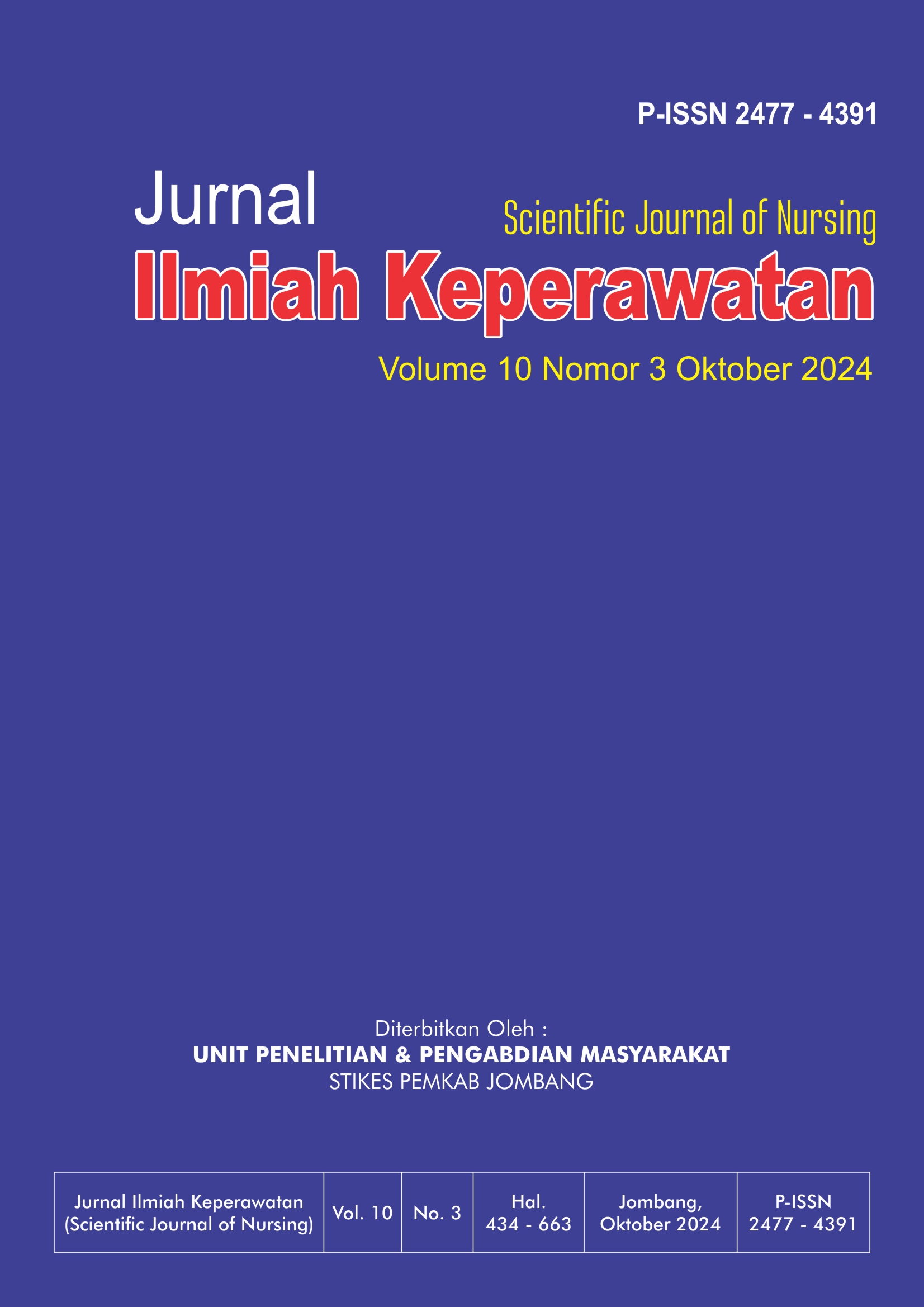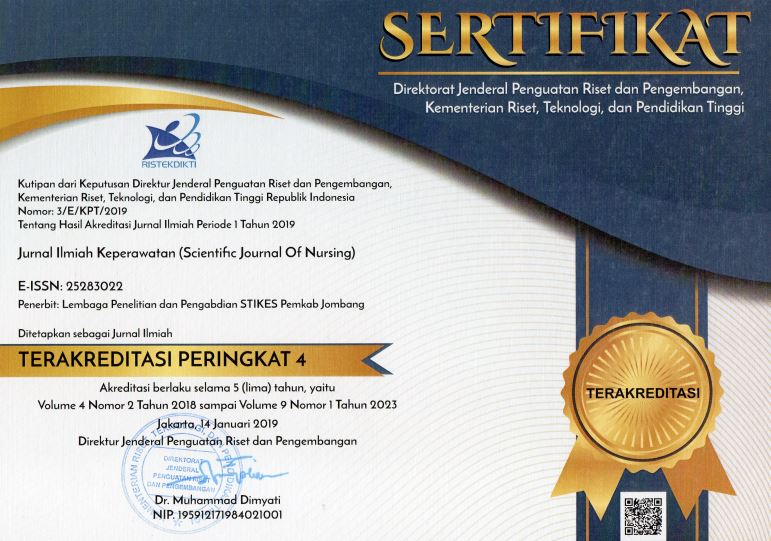PENGARUH PSIKOEDUKASI BERBASIS NEURO LINGUISTIC PROGRAMMING TERHADAP TINGKAT ADIKSI GAWAI PADA ANAK
The Effect of Neuro-Linguistic Programming Based Psychoeducation on the Children's Device Addiction Level
DOI:
https://doi.org/10.33023/jikep.v10i3.2186Keywords:
Addiction, Children, Psychoeducation, NLP, Neuro Linguistic ProgrammingAbstract
Latar Belakang : Pada tahun 2019, rata-rata waktu penggunaan internet melalui gawai di Indonesia mencapai 8 jam/hari. Hasil studi pendahuluan tanggal 04 September 2021 terhadap siswa Kelas VI di SDN Pandian 1 Sumenep yang menggunakan smartphone, didapatkan 62,5% siswa memiliki rerata penggunaan smartphone >7 jam/hari untuk mengakses media sosial dan bermain gim. Angka tersebut melampaui rerata global yang hanya menghabiskan waktu 6 jam 43 menit per harinya. Intervensi untuk merubah perilaku adiksi harus dimulai sejak awal dan dapat diwujudkan melalui Neuro-linguistic Programming (NLP). Tujuan: Penelitian ini bertujuan untuk mengetahui pengaruh psikoedukasi berbasis NLP terhadap tingkat adiksi gawai pada anak. Metode: quasi eksperimen dengan pendekatan one group pre-post-test dan melibatkan 32 responden yang dipilih melalui purposive sampling. Hasil: Setelah diberikan psikoedukasi sebanyak 3 kali pertemuan dengan durasi masing-masing 20 menit, nilai screen time pada aplikasi “Stayfree-Kesehatan Digital” yang sudah diunduh sebelumnya oleh responden menunjukkan penurunan dari yang sebelumnya 7,20 jam/hari menjadi 6,43 jam/hari. Nilai kuesioner SAS-SV juga menunjukkan penuruan tingkat adiksi sebesar 87.5% dari yang sebelumnya berat menjadi ringan. Tidak ditemukan hubungan yang signifikan antara tingkat pendidikan dan penghasilan orang tua terhadap tingkat adiksi gawai pada anak dengan nilai Sig. (2-tailed) masing-masing sebesar 0,688 dan 0,323. Hasil penelitian menunjukkan nilai Sig.(2-tailed) dalam uji Paired Sample t-Test sebesar 0,001. Kesimpulan: psikoedukasi berbasis Neuro Linguistic Programming dapat memberikan pengaruh yang signifikan terhadap tingkat adiksi gawai pada anak. Diharapkan siswa dengan dampingan orang tua dapat lebih mengembangkan potensi dalam diri guna mengurangi penggunaan gawai yang berpotensi menyebabkan adiksi dan permasalahan kesehatan lainnya
Downloads
References
Agusta, D. (2016). Faktor-faktor resiko kecanduan menggunakan smartphone. E-Journal Bimbingan Dan Konseling, 5(3), 86–96.
Amalia, R. F., & Hamid, A. Y. S. (2020). Smartphone Addiction, Children’s Mental Health, and the Role of Parenting. Jurnal Ilmu Keperawatan Jiwa, 3(2), 221–240.
Arthy, C. C., Effendy, E., Amin, M. M., Loebis, B., Camellia, V., & Husada, M. S. (2019). Indonesian version of addiction rating scale of smartphone usage adapted from smartphone addiction scale-short version (SAS-SV) in junior high school. Open Access Macedonian Journal of Medical Sciences, 7(19), 3235–3239. https://doi.org/10.3889/oamjms.2019.691
Bandler, R., & Grinder, J. (1975). The structure of magic (Vol. 1). Science and Behavior Books Palo Alto, CA.
Che, D., Hu, J., Zhen, S., Yu, C., Li, B., Chang, X., & Zhang, W. (2017). Dimensions of emotional intelligence and online gaming addiction in adolescence: The indirect effects of two facets of perceived stress. Frontiers in Psychology, 8, 1206.
Clark, K. E., David, R. M., Guinn, R., Kramarz, K. W., Lampi, M. A., & Staples, C. A. (2011). Modeling human exposure to phthalate esters: a comparison of indirect and biomonitoring estimation methods. Human and Ecological Risk Assessment: An International Journal, 17(4), 923–965.
Ekhtiari, H., Rezapour, T., Aupperle, R. L., & Paulus, M. P. (2017). Neuroscience-informed psychoeducation for addiction medicine: A neurocognitive perspective. Progress in Brain Research, 235, 239–264.
Faiza Zeb, Ansa Hameed, Shaista Zeb. (2021). Is Neurolinguistic Programming a Myth? a Review of Nlp Studies. Pakistan Journal of Educational Research, 4(1), 368–380. https://doi.org/10.52337/pjer.v4i1.167
Gimeno-Gilles, C., Lelièvre, E., Viau, L., Malik-Ghulam, M., Ricoult, C., Niebel, A., Leduc, N., Limami, A. M., Schmidt-Lebuhn, A. N., Fuchs, J., Hertel, D., Hirsch, H., Toivonen, J., Kessler, M., Loureiro, J., Lavania, U. C. U. C., Srivastava, S., Lavania, S., Basu, S., … Yao, J. L. (2016). No ????????????????????? ?????????????????Title. Euphytica, 18(2), 22280.
Hadi, M. F. Z., & Zubaidah, Z. (2015). Pemanfaatan Konseling Neuro Linguistic Programming dalam Mengatasi Kesulitan Belajar Siswa Sekolah Dasar. Jurnal Dakwah Risalah, 26(4), 174–182.
Heap, M. (2008). The validity of some early claims of neuro-linguistic programming. Skeptical Intelligencer, 11, 6–13.
Kerna, N. A., Nwokorie, U., Hafid, A., Pruitt, K. D., DelGiodice, M. J., Atolagbe, O. A., Nnake, I., Holets, H. M., & Jean-Baptiste, F. (2021). Neurolinguistic Programming in Practice: More Empirical than Magical. EC Psychology and Psychiatry, 10, 93–104.
King, M., Novik, L., & Citrenbaum, C. (1983). Irresistible communication: Creative skills for the health professional. Saunders.
Kudliskis, V. (2013). Neuro?linguistic programming and altered states: encouraging preparation for learning in the classroom for students with special educational needs. British Journal of Special Education, 40(2), 86–95.
Kwon, M., Kim, D.-J., Cho, H., & Yang, S. (2013). The smartphone addiction scale: development and validation of a short version for adolescents. PloS One, 8(12), e83558.
Kwon, M., Lee, J.-Y., Won, W.-Y., Park, J.-W., Min, J.-A., Hahn, C., Gu, X., Choi, J.-H., & Kim, D.-J. (2013). Development and validation of a smartphone addiction scale (SAS). PloS One, 8(2), e56936.
Lazarus, J. (2010). Successful NLP. Hachette UK.
Lopez-Fernandez, O. (2017). Short version of the Smartphone Addiction Scale adapted to Spanish and French: Towards a cross-cultural research in problematic mobile phone use. Addictive Behaviors, 64, 275–280.
Lovheim, H. (2012). A new three-dimensional model for emotions and monoamine neurotransmitters. Medical Hypotheses, 78, 341–348.
Mohanaundaram, K., & Kumar, P. K. (2020). Neuro Linguistic Programming And Learning Styles. Journal of Critical Reviews, 7(15), 3940–3943.
Mun, S. Y., & Lee, B. S. (2015). Effects of an integrated internet addiction prevention program on elementary students’ self-regulation and internet addiction. Journal of Korean Academy of Nursing, 45(2), 251–261.
Nurhaeda, N. (2018). Dampak Penggunaan Gadget Pada Anak Usia Dini Dalam Pan-Dangan Islam Di Paud Terpadu Mutiara Hati Palu. ECEIJ (Early Childhood Education Indonesian Journal), 1(2), 70–78.
O’Connor, J., & Seymour, J. (2011). Introducing NLP: Psychological skills for understanding and influencing people. Conari Press.
Pediatrics, A. A. of. (2016). American Academy of Pediatrics announces new recommendations for children’s media use.
Rusmianto, A., & Putra, K. P. (2020). Studi Pengetahuan Orang Tua tentang Gawai dan Pemberian Gawai pada Anak Usia 9-12 Tahun. Jurnal Keperawatan Muhammadiyah, 5(1), 135–141. https://doi.org/10.30651/jkm.v5i1.3475
Scott, D. A., Valley, B., & Simecka, B. A. (2017). Mental health concerns in the digital age. International Journal of Mental Health and Addiction, 15(3), 604–613.
Siswoyo, S., & Bakar, A. (2015). Pengaruh Psikoedukasi terhadap Pengetahuan Intensi, dan Sick Role Behaviour Ajzen. Jurnal Ilmu Keperawatan Universitas Brawijaya. Vol. 3 No. 2.
Sohn, S. Y., Rees, P., Wildridge, B., Kalk, N. J., & Carter, B. (2021). Correction to: Prevalence of problematic smartphone usage and associated mental health outcomes amongst children and young people: a systematic review, meta-analysis and GRADE of the evidence. BMC Psychiatry, 21(1), 1.
Stipancic, M., Renner, W., Schütz, P., & Dond, R. (2010). Effects of Neuro-Linguistic Psychotherapy on psychological difficulties and perceived quality of life. Counselling and Psychotherapy Research, 10(1), 39–49.
Sunita, I., & Mayasari, E. (2018). Pengawasan orangtua terhadap dampak penggunaan gadget pada anak. Jurnal Endurance: Kajian Ilmiah Problema Kesehatan, 3(3), 510–514.
Tamura, H., Nishida, T., Tsuji, A., & Sakakibara, H. (2017). Association between excessive use of mobile phone and insomnia and depression among Japanese adolescents. International Journal of Environmental Research and Public Health, 14(7), 701.
Twenge, J. M., & Campbell, W. K. (2018). Associations between screen time and lower psychological well-being among children and adolescents: Evidence from a population-based study. Preventive Medicine Reports, 12, 271–283.
Van Deursen, A. J. A. M., Bolle, C. L., Hegner, S. M., & Kommers, P. A. M. (2015). Modeling habitual and addictive smartphone behavior: The role of smartphone usage types, emotional intelligence, social stress, self-regulation, age, and gender. Computers in Human Behavior, 45, 411–420.
Walker, L. (2004). Changing with NLP: A casebook of neuro-linguistic programming in medical practice. Radcliffe Publishing.
Yuliawan, T. P. (2014). NLP: The Art of Enjoying Life. Serambi Ilmu Semesta.
Yunfei, Z., Ning, X., YunQing, Z., Zhen, C., & YuFeng, W. (2019). Smartphone addiction may be associated with adolescent hypertension: a cross-sectional study among junior school students in China. BMC Pediatrics, 19(310).
Zaharia, C., Reiner, M., & Schütz, P. (2015). Evidence-based neuro linguistic psychotherapy: a meta-analysis. Psychiatria Danubina, 27(4), 0–363.
Published
How to Cite
Issue
Section
Authors who publish with Jurnal Ilmiah Keperawatan (Scientific Journal of Nursing) agree to the following terms:
- Authors retain copyright and grant Jurnal Ilmiah Keperawatan (Scientific Journal of Nursing) the right of first publication with the work simultaneously licensed under a Creative Commons Attribution 4.0 International License that allows others to remix, adapt and build upon the work with an acknowledgment of the work's authorship and of the initial publication in Jurnal Ilmiah Keperawatan (Scientific Journal of Nursing).
- Authors are permitted to copy and redistribute the journal's published version of the work (e.g., post it to an institutional repository or publish it in a book), with an acknowledgment of its initial publication in Jurnal Ilmiah Keperawatan (Scientific Journal of Nursing).











